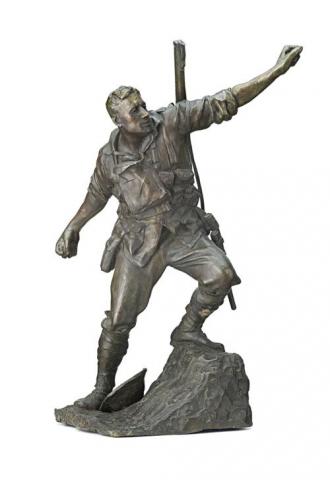AUSTRALIAN SOLDER, MAQUETTE FOR BROKEN HILL WAR MEMORIAL, 1922
Charles Webster Gilbert
bronze
56.5 cm height
signed, inscribed and dated on base: C. Web Gilbert / Sculptor & Founder / 1922
The Estate of Pro Hart, Broken Hill, New South Wales
Charles Webster Gilbert's War Memorial at Broken Hill, dubbed 'The Bomber', was unveiled by Australia's hero-general, Lt. General Sir John Monash on 11 October 1925. Filled with vigour, it is unlike most other World War I memorials, which are given over to melancholic reflection. In many towns across the country, figures of pensive soldiers, heads lowered and rifles inverted, are the norm. Gilbert's bare-headed Digger with sleeves rolled up is ready for action, an archetypal image of the ANZAC, defiantly taking on the enemy. The rifle slung across his shoulder is pointedly bayoneted. His arm is extended, ready to hurl a Mills Bomb (today's hand grenade) at the unseen foe. Like other great monuments to freedom, Gilbert's soldier has reminiscences of Bernini's great David, sizing up Goliath before letting fly the telling stone from his sling shot.
Arriving in London in 1914, Gilbert was appointed sculptor in the War Records Section of the A.I.F., visiting the grim battlefields to ensure the accuracy and veracity of his models. Returning to Australia with A.I.F. in 1920, he continued with War Records for another year and worked on numerous commissions for major memorials over the next five years. Chief among these are the bronze Memorial to A.I.F. 2nd Division at Mont StQuentin, France, 1920-25, and the A.N.Z.A.C. Memorial, Port Said, Egypt, 1923-25. Others include memorials for the Melbourne Chamber of Manufactures 1921, another in the Australian Medical Association, Parkville, Melbourne, and memorials in Adelaide and Shepparton. Gilbert also created many bronze portrait busts of leading political figures such as Alfred Deakin and artists Frederick McCubbin, John Shirlow, and John Mather. His greatest work is arguably the large bronze, the Bass and Flinders Memorial, 1923-25, proudly positioned in Swanston Street, Melbourne.
Gilbert was commissioned to sculpt the figure of the soldier for the Broken Hill War Memorial on 22 May 1923, the committee responsible believing that he was 'the best and most skilled sculptor available.'1 When Gilbert supplied the committee with a photograph of his proposed work, he wrote,'It is really one of the best designs I have made', adding that if Broken Hill was not interested, it was wanted for Sydney.2 The committee, however, considered it to be 'true in every detail'.3 Gilbert's model was W.H. 'Abdul' Guest, anex-sergeant in the A.I.F., and Monash was said to have looked on while Gilbert worked. Gilbert is reported to have said of his work, 'I want to satisfy not only the art critic and military theorist, but the Dinkum Digger critic.'4 This he captured in the bronze maquette, worked first in clay directly from the model. Such was the artist's popularity that he died from overwork a few days before the unveiling of the Broken Hill memorial.
1. Dowd, Andy, 'The Broken Hill War Memorial', Journals and Proceedings of the Broken Hill Historical Society, vol.25, December 1989, p. 13
2. Ibid, pp. 13-14
3. Inglis, K. S., Sacred Places: War Memorials in the Australian Landscape, Melbourne 1998, Miegunyah Press, p. 146
4. Rainbird, Paul, 'Representing Nation, Divided Community: The Broken Hill War Memorial, New South Wales, Australia', World Archaeology, vol.35, no. 1, June 2003, p. 29
DAVID THOMAS
